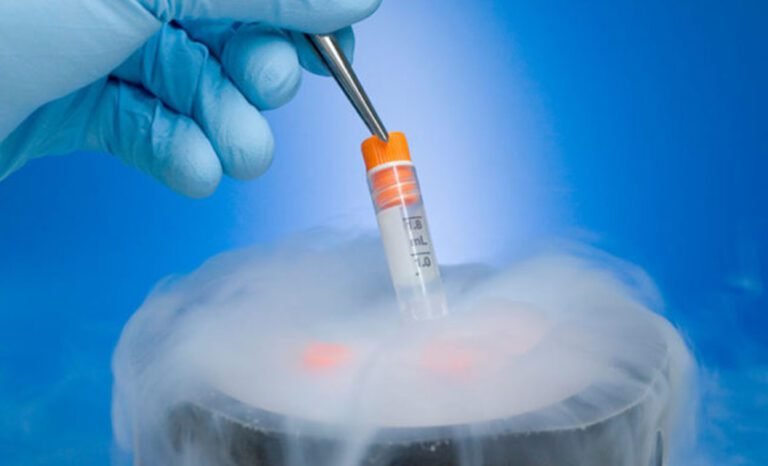Cryopreservation
- Home
- Cryopreservation

Embryo cryopreservation is the process of freezing and storing embryos and is a part of most in vitro fertilization programs. The process is chosen for reasons as varied as providing an additional chance for pregnancy, or saving embryos in the face of certain medical treatments.
Oocyte cryopreservation is a process in which a woman’s eggs (oocytes) are extracted, frozen and stored as a method to preserve reproductive potential in women of reproductive age.
Oocyte cryopreservation is a process in which a woman’s eggs (oocytes) are extracted, frozen and stored as a method to preserve reproductive potential in women of reproductive age.
Why is embryo cryopreservation done?
There are many reasons a man and woman might choose to freeze and store their embryos:
- They may feel it is a better option than having the extra embryos destroyed.
- It can provide another chance to get pregnant if the IVF process fails the first time. The couple will not have to go through IVF again.
- If the man and woman have a baby, they can use the embryos later to have a second baby.
- The woman can save embryos before she begins treatments, such as for cancer, that might reduce or eliminate her chances of getting pregnant.
- The embryos could be saved and given to someone else in a donor program.
- The embryos could be saved and donated for research.
How is embryo cryopreservation done?
A cell is made up mostly of water. The main concern when freezing embryos is ice forming in and between the cells. Ice crystals can hurt the cell wall, and can harm the small structures inside the cell.
The embryo must be protected during the freezing process. This is done using special fluids called cryoprotective agents (CPAs). CPAs are like “anti-freeze” for cells.
Doctors use two different methods to freeze and preserve embryos: slow programmable freezing and vitrification.
In the slow freezing method, the embryos are frozen slowly, in stages. The CPAs are added to the embryos in increasing strengths over 10 to 20 minutes. Then the embryos are slowly cooled over two hours in a machine that lowers the temperature minute by minute. Once frozen, the embryos are stored in liquid nitrogen at -321° Fahrenheit (-196.1° Celsius).
Vitrification is a rapid freezing technique that uses much higher strengths of CPAs. With this method, the doctor first mixes the CPAs with the embryos. CPAs that are very strong can also hurt the cell. To prevent this, the embryos are quickly placed into the liquid nitrogen. This process changes them into an almost-solid state, like glass. In this state, ice is unable to form.
When needed, the embryos are slowly thawed. They are soaked in special fluids to remove the CPAs. This also restores the cell’s normal water balance.
When is embryo cryopreservation done?
Embryos are often frozen from one to six days after they are made.
How long can embryos be stored?
Once they are frozen, the embryos are stored in sealed liquid nitrogen freezers. Embryos can be frozen in liquid nitrogen for many years. It is not known how long embryos can be frozen safely and still be useful. Some countries have set time limits on how long embryos can be stored.
Egg freezing, or oocyte cryopreservation, is a process in which a woman’s eggs (oocytes) are extracted, frozen and stored as a method to preserve reproductive potential in women of reproductive age. The first human birth from a frozen oocyte was reported in 1986. Oocyte cryopreservation has advanced greatly over the past few years, with improved overall success of eggs surviving the freezing process. It is no longer considered an experimental procedure by the American Society for Reproductive Medicine. The techniques leading to enhanced gamete survival, potential fertilization and live birth rates allow women a much greater degree of autonomy than was possible even in the past 5 years.
Who Needs Egg (oocyte) Freezing?
Cryopreservation of the oocytes can be considered for a variety of reasons:
- Women with cancer requiring chemotherapy and/or pelvic radiation therapy that may affect fertility.
- Surgery that may cause damage to the ovaries.
- Risk of premature ovarian failure because of chromosomal abnormalities (e.g. Turner syndrome, fragile X syndrome), or family history of early menopause.
- Ovarian disease with risk of damage to the ovaries.
- Genetic mutations requiring removing the ovaries (e.g. BRCA mutation).
- Fertility preservation for social or personal reasons to delay childbearing.
How Will the Eggs be Used in the Future?
When the woman is ready to use the frozen eggs to achieve pregnancy, these cryopreserved eggs are placed in warming solution and assessed. Those eggs that survived the freezing process are fertilized with intracytoplasmic sperm injection (ICSI), where a single sperm is injected directly into the egg, and the fertilized eggs will grow in culture until the embryo(s) are ready to be transferred into the uterus to achieve pregnancy, typically 3-5 days after fertilization.
What are the Chances of a Successful Pregnancy Using Frozen-thawed Oocytes?
Egg Freezing Success Rates
Clinical pregnancy rates have been estimated between 4-12% per oocyte. But since egg freezing is relatively new, more data will be needed to have a better idea on these success rates. In general, the two most important factors in determining the probability of a live birth are the woman’s age at the time of egg freezing and the number of available eggs.
Are There Effects on the Offspring Conceived from Frozen-thawed Oocytes?
Available data comparing births resulting from previously frozen oocytes with those from fresh oocytes have not shown an increased risk of congenital anomalies. More long-term data, however, will be needed to further assess these risks.
